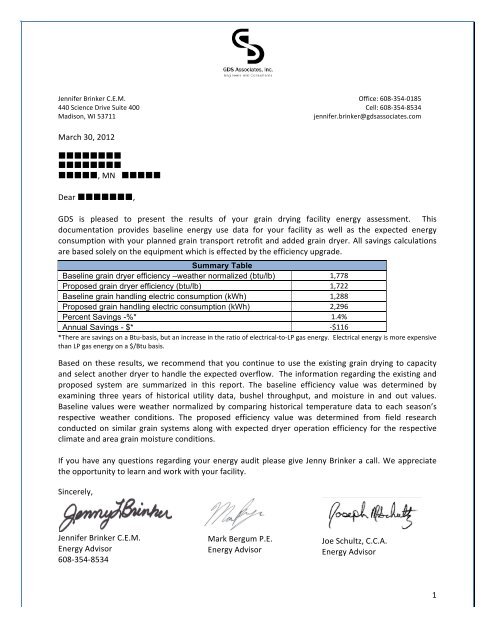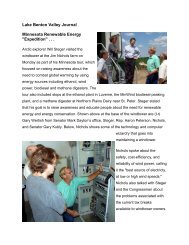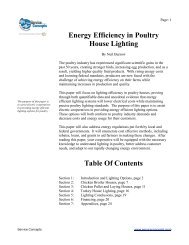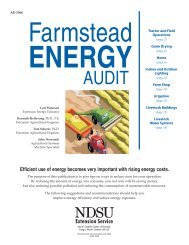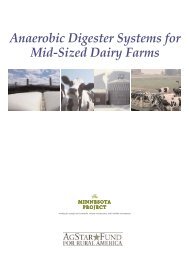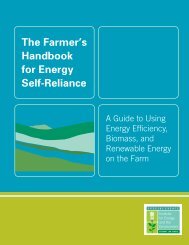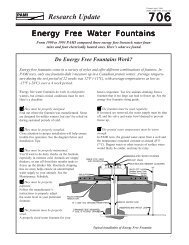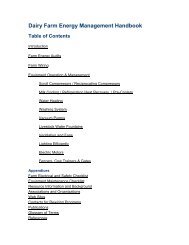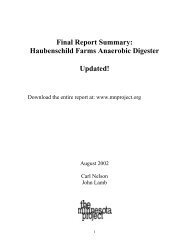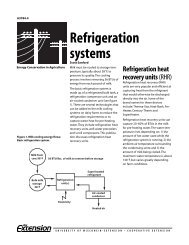General grain dryer report.pdf - The Minnesota Project
General grain dryer report.pdf - The Minnesota Project
General grain dryer report.pdf - The Minnesota Project
Create successful ePaper yourself
Turn your PDF publications into a flip-book with our unique Google optimized e-Paper software.
Jennifer Brinker C.E.M. <br />
Office: 608-‐354-‐0185 <br />
440 Science Drive Suite 400 Cell: 608-‐354-‐8534 <br />
Madison, WI 53711 <br />
jennifer.brinker@gdsassociates.com <br />
March 30, 2012 <br />
¢¢¢¢¢¢¢¢ <br />
¢¢¢¢¢¢¢¢ <br />
¢¢¢¢¢, MN ¢¢¢¢¢ <br />
Dear ¢¢¢¢¢¢¢, <br />
GDS is pleased to present the results of your <strong>grain</strong> drying facility energy assessment. This <br />
documentation provides baseline energy use data for your facility as well as the expected energy <br />
consumption with your planned <strong>grain</strong> transport retrofit and added <strong>grain</strong> <strong>dryer</strong>. All savings calculations <br />
are based solely on the equipment which is effected by the efficiency upgrade. <br />
Summary Table<br />
Baseline <strong>grain</strong> <strong>dryer</strong> efficiency –weather normalized (btu/lb)<br />
1,778 <br />
Proposed <strong>grain</strong> <strong>dryer</strong> efficiency (btu/lb)<br />
1,722 <br />
Baseline <strong>grain</strong> handling electric consumption (kWh)<br />
1,288 <br />
Proposed <strong>grain</strong> handling electric consumption (kWh)<br />
2,296 <br />
Percent Savings -%*<br />
1.4% <br />
Annual Savings - $*<br />
-‐$116 <br />
*<strong>The</strong>re are savings on a Btu-‐basis, but an increase in the ratio of electrical-‐to-‐LP gas energy. Electrical energy is more expensive <br />
than LP gas energy on a $/Btu basis. <br />
Based on these results, we recommend that you continue to use the existing <strong>grain</strong> drying to capacity <br />
and select another <strong>dryer</strong> to handle the expected overflow. <strong>The</strong> information regarding the existing and <br />
proposed system are summarized in this <strong>report</strong>. <strong>The</strong> baseline efficiency value was determined by <br />
examining three years of historical utility data, bushel throughput, and moisture in and out values. <br />
Baseline values were weather normalized by comparing historical temperature data to each season’s <br />
respective weather conditions. <strong>The</strong> proposed efficiency value was determined from field research <br />
conducted on similar <strong>grain</strong> systems along with expected <strong>dryer</strong> operation efficiency for the respective <br />
climate and area <strong>grain</strong> moisture conditions. <br />
If you have any questions regarding your energy audit please give Jenny Brinker a call. We appreciate <br />
the opportunity to learn and work with your facility. <br />
Sincerely, <br />
Jennifer Brinker C.E.M. <br />
Energy Advisor <br />
608-‐354-‐8534 <br />
Mark Bergum P.E. <br />
Energy Advisor <br />
Joe Schultz, C.C.A. <br />
Energy Advisor <br />
1
Preface and Acknowledgements <br />
Despite the importance of greenhouses to <strong>Minnesota</strong>’s economy, little <br />
has been done to bring operations up to speed from an efficiency <br />
standpoint. <strong>The</strong> <strong>Minnesota</strong> <strong>Project</strong> recognized the increased demand <br />
for green house auditors through its previous work on greenhouse <br />
efficiency and the need for energy audits for federal rural funding <br />
programs like the USDA’s Rural Development and Natural Resources <br />
Conservation Service. <br />
This energy audit was conducted as part of an energy auditor training series. Twenty trainees who work <br />
in agriculture or energy fields collaborated to collect and analyze energy information related to <strong>grain</strong>-drying<br />
operations. <strong>The</strong> final <strong>report</strong> was compiled and reviewed by a GDS Associates, Inc., an energy <br />
auditor firm and certified USDA Technical Service Provider. <br />
This project was made possible by a grant from the U.S. Department <br />
of Energy and the <strong>Minnesota</strong> Department of Commerce (Division of <br />
Energy Resources) through the American Recovery and <br />
Reinvestment Act of 2009 (ARRA).<br />
2
3 <br />
4 <br />
1 <br />
IBD <br />
2 <br />
1 – 10,000 Bu Corn Storage Bin <br />
2 -‐ 45,000 Bu. Corn Storage Bin <br />
3 – 65,000 Bu Corn Storage Bin <br />
4 –65,000 Bu Corn Storage Bin <br />
BB – 4,400 Bu Bean Bin <br />
WB – 9,200 Bu Wet Bin N <br />
IBD – In Bin Dryer <br />
S<br />
B <br />
W<br />
B <br />
Situation Report: <br />
<strong>The</strong> farm and <strong>grain</strong> drying facility is in southwest <strong>Minnesota</strong>. Over the past 3 years the farm has <br />
averaged a throughput of 195,000 bushels of corn per year. In the 2011 drying season this value totaled <br />
192,000 bushels of corn. Business plans include expanding the volume of <strong>grain</strong> dried and to add both a <br />
new mixed flow-‐type <strong>dryer</strong> and pneumatic (forced air) <strong>grain</strong> transport system. With the proposed new <br />
<strong>grain</strong> drying set-‐up, <strong>The</strong> farm is expecting to dry 250,000 bushels of corn per year. An average field <br />
moisture content of 23.0% is used in the proposed <strong>grain</strong> facility calculations as this is the state average. <br />
<strong>The</strong> farm plans to dry <strong>grain</strong> down to 14.0% for long term storage, thus this will be used as the final point <br />
value. <br />
An average propane energy cost of $1.47/gallon was noticed over the past 3 drying seasons while a <br />
current electrical energy cost of $0.115/kWh was noticed (based on the past 12 months). For this <strong>report</strong>, <br />
the average gallon cost will be used for the proposed system while the current electrical cost will be <br />
used. This methodology is chosen because thermal energy costs fluctuate both up and down, while <br />
electrical costs are generally stable or increase gradually with time. Historical energy data can be seen in <br />
the attached documents. <br />
3
Current Dryer System: <br />
<strong>The</strong> current <strong>dryer</strong> system being utilized is a Shivvers <strong>dryer</strong> <br />
and auger system within a 27-‐foot <strong>grain</strong> bin. This unit is a <br />
continuous in-‐bin <strong>dryer</strong>. <strong>The</strong> current <strong>dryer</strong> has a <br />
throughput capacity of 1000 bushel per hour with a 3-‐point <br />
decrease. This unit is undersized for the needs of the <br />
facility’s future <strong>grain</strong> production. <strong>The</strong> efficiency of the <br />
current <strong>dryer</strong> is estimated to be 1,778 Btu/lb of water <br />
removed. This efficiency value was determined from the <br />
farm’s historical energy usage and bushel throughput data <br />
obtained from the producer. It should be noted that the <br />
farm is operating at an optimal drying efficiency, using a <br />
recommended energy-‐efficient <strong>grain</strong> <strong>dryer</strong>. It is not <br />
uncommon to audit <strong>dryer</strong>s in operation that use more than <br />
2200 btu/lb of water removed. <strong>The</strong> current <strong>grain</strong> handling <br />
system is an auger system with four motors that total 8.8 <br />
kW of power load. <br />
Figure 1. Existing Shivvers Dryer Interior <br />
Proposed Dryer System: <br />
<strong>The</strong> farm is proposing the installation of a mixed flow type <br />
of <strong>grain</strong> <strong>dryer</strong> and to retrofit their current auger system with <br />
an 18.8 kW pneumatic (air) <strong>grain</strong> handling system. <strong>The</strong> <br />
additional <strong>dryer</strong> and pneumatic <strong>grain</strong> handling system will Figure 2. Current Shivvers in-‐bin <strong>dryer</strong> with fan. <br />
accommodate plans for adding about 50,000 bushels to the <br />
current 200,000 bushels per season <strong>grain</strong> throughput. <strong>The</strong> farm plans to run both the current Shivvers <br />
<strong>dryer</strong> plus the mixed flow <strong>dryer</strong>. Mixed flow <strong>dryer</strong>s are upright columns where <strong>grain</strong> flows down, <br />
passing through multiple heating zones. Mixed flow <strong>dryer</strong>s are recommended as an energy efficient <br />
<strong>grain</strong> <strong>dryer</strong> choice, and use 25% to 40% less energy than a standard cross-‐flow <strong>dryer</strong> (considering a <br />
cross-‐flow without heat recovery options) while maintaining high <strong>grain</strong> flows and volumes of drying. <strong>The</strong> <br />
efficiency of the proposed <strong>dryer</strong> used in combination with the existing Shivvers <strong>dryer</strong> is estimated to be <br />
1,722 Btu/lb of water removed. This data was obtained from research data conducted in the field on <br />
similar models <strong>grain</strong> systems. <br />
<strong>The</strong> farm plans to retrofit the existing bin-‐to-‐bin auger transport system with a pneumatic (air) <strong>grain</strong> <br />
transport system. <strong>The</strong> current auger system includes four 3-‐horsepower (12 hp) direct-‐drive (one <br />
speed) motors and the proposed system will replace these motors with one, 30-‐horsepower soft start <br />
and stop motor. Components of pneumatic <strong>grain</strong> systems typically include the blower fan and motor, <br />
air lock which drops <strong>grain</strong> into airstream, and velocity compensators that control <strong>grain</strong> speed at elbows, <br />
prevents damage. It should be noted that although the pneumatic <strong>grain</strong> system will be more convenient <br />
and allow less run-‐time, the electricity consumption may increase versus the existing auger system. <br />
Historical Utility Data: <br />
Data provided below was obtained from farm utility bill information provided by McLeod Cooperative<br />
Power Association and from the farm’s owners (LP is purchased from Hutchinson Coop). <strong>The</strong> usage seen <br />
below only includes energy used during the drying season. An average LP gas energy cost of <br />
$1.47/gallon was noticed over the past 3 drying seasons while a current electrical energy cost of <br />
$0.115/kWh was noticed. <br />
4
average <br />
year <br />
bushels of <br />
corn dried <br />
LP gas cost for <br />
season <br />
LP gas used <br />
(MMBtu) <br />
electricity cost <br />
for season <br />
electricity <br />
used <br />
(MMBtu) <br />
annual <br />
efficiency <br />
(btu/lb) <br />
2011 192,000 $3,658 183.0 $2,907 76.9 1,381 <br />
2010 192,000 $6,296 411.8 $1,914 56.3 1,477 <br />
2009 201,000 $24,549 1,921.5 $4,995 166 2,414 <br />
Table 1. Historical <strong>grain</strong> throughput and energy used to dry <strong>grain</strong>. <br />
Grain Drying Energy and Cost Savings: <br />
Savings are based upon utility data obtained from the farm between 2009 and 2011 drying seasons. <br />
Savings do not account for fuel price fluctuations or changes in crop harvest moisture levels. Cost <br />
savings were based upon energy cost averages shown above. A <strong>grain</strong> throughput value of 250,000 was <br />
chosen based upon projected future farm totals. <strong>The</strong> overall savings with the new <strong>grain</strong> <strong>dryer</strong> is 1783 <br />
MMBtu. This value equals an efficiency gain of 1.4% with a cost increase totaling $116 annually. <br />
average <br />
bushels <br />
per year <br />
LP gas used <br />
per year <br />
(MMBtu) <br />
electricity <br />
used per year <br />
(MMBtu) <br />
Energy <br />
totals <br />
[MMBtu] <br />
drying cost per <br />
bushel <br />
[23% to 14%] <br />
annual <br />
energy cost <br />
Current <strong>dryer</strong> <br />
1,973 74 2,047 $0.14 $34,093 <br />
Proposed <strong>dryer</strong> 250,000 1,912 106 2,018 $0.14 $34,209 <br />
Savings: 61 -‐33 29 $0.00 -‐$116 <br />
Table 2. Summary of current and proposed <strong>grain</strong> operation energy consumption per season. <br />
As stated in the introductory letter, the additional <strong>dryer</strong> and pneumatic handling system offer savings on <br />
a Btu-‐basis, but an increase in the ratio of electrical-‐to-‐LP gas energy. Electrical energy is more <br />
expensive than LP gas energy on a $/Btu basis. <br />
Greenhouse Gas Reduction: <br />
Emission total and greenhouse gas reduction savings for electrical energy are only associated with <br />
emissions from the power plant. LP gas emission savings are attributed to the reduction in combusted <br />
fuel needed to dry a bushel of <strong>grain</strong>. Greenhouse gas emissions reductions metrics are provided by GDS <br />
Associates, Inc. using Climate Registry protocols set forth by the U.S. EPA in Table 3. <br />
Metric tons carbon <br />
dioxide equivalent from <br />
LP gas (mt CO 2 e) <br />
Metric tons carbon <br />
dioxide equivalent from <br />
electric energy <br />
(mt CO 2 e) <br />
Total metric tons carbon <br />
dioxide equivalent <br />
(mt CO 2 e) <br />
Current <strong>dryer</strong> 125 18 144 <br />
Proposed <strong>dryer</strong> 121 26 148 <br />
Savings [ mt CO 2 e] 4 -‐8 -‐4 <br />
Table 3. Greenhouse gas statistics for the proposed system. <br />
5
3 <br />
4 <br />
1 <br />
IBD <br />
2 <br />
1 – 10,000 Bu Corn Storage Bin <br />
2 -‐ 45,000 Bu. Corn Storage Bin <br />
3 – 65,000 Bu Corn Storage Bin <br />
4 –65,000 Bu Corn Storage Bin <br />
BB – 4,400 Bu Bean Bin <br />
WB – 9,200 Bu Wet Bin N <br />
IBD – In Bin Dryer <br />
S<br />
B <br />
W<br />
B <br />
Figure 3. Grain facility aerial photo and <strong>dryer</strong> and system layout. <br />
Grain Facility Footprint: <br />
Figure 4. Top of Shivvers <strong>dryer</strong> and <br />
unload auger to Bin 2. <br />
<strong>The</strong> current drying system is augured to 5 holding bins on site. <strong>The</strong> <br />
bins and their holding capacities are listed below. <strong>The</strong>se structures <br />
encompass the impacted storage units affected by the new <strong>grain</strong> <br />
drying system. <br />
Bin Name <br />
Holding Size (bushels) <br />
1 10,000 <br />
2 45,000 <br />
3 65,000 <br />
4 65,000 <br />
“Bean Bin” <br />
4,400 <br />
Wet Bin <br />
9,200 <br />
Table 4. Grain storage bin labels and sizing. <br />
6
Motor Replacement Inventory: <br />
<strong>The</strong> following is a listing of motors that are currently located on site at the <strong>grain</strong> facility which will be <br />
affected by the new pneumatic <strong>grain</strong> transport system. <strong>The</strong> owners hope to retrofit the current bin-‐to-bin<br />
transport system with a 30 horsepower, pneumatic (air) <strong>grain</strong> handling system. A few motors <br />
changes will be conducted in order to complete the retrofit. <strong>The</strong> affected motors are inventoried below <br />
in table 5. <br />
Application <br />
(description) <br />
current <br />
motor <br />
size <br />
(hp) <br />
current <br />
motor <br />
efficiency (%) <br />
current <br />
motor <br />
size load <br />
factor <br />
current <br />
motor <br />
run <br />
hours <br />
per year <br />
Bin 2 Auger 3 85.0% 0.85 144 <br />
Bin 4 Auger 3 85.0% 0.85 144 <br />
Bin 3 Auger 3 85.0% 0.85 144 <br />
Other Bin Auger 3 85.0% 0.85 144 <br />
Table 5. Motor schedule for the current and proposed <strong>grain</strong> transfer systems. <br />
proposed <br />
motor <br />
size (hp) <br />
proposed <br />
motor <br />
efficiency <br />
(%) <br />
proposed <br />
motor <br />
run <br />
hours <br />
per year <br />
proposed <br />
motor <br />
load <br />
factor <br />
30 95.0% 122 0.8 <br />
Application <br />
(description) current kW <br />
current <br />
kWh <br />
Bin 2 Auger 2.2 322 <br />
Bin 4 Auger 2.2 322 <br />
Bin 3 Auger 2.2 322 <br />
Other Bin <br />
Auger 2.2 322 <br />
Total: 1,288 <br />
proposed <br />
kWh <br />
2,296 <br />
proposed <br />
kW <br />
18.8 <br />
Table 6. Motor energy use for the current and proposed <strong>grain</strong> transfer systems. <br />
kWh <br />
Savings <br />
-‐1,008 <br />
<strong>The</strong> farmer is interested in a pneumatic handling system because it will allow for more flexibility in <br />
unloading. Plus, it was stated that he would be able to reduce energy consumption and load as a result <br />
of the pneumatic <strong>grain</strong> relay system. He projects the pneumatic system will come with a soft-‐start <br />
motor and may allow for 15% less run time as the <strong>grain</strong> will be transported faster than the current <br />
system. However, while time of use may decrease, there will be an anticipate increase in motor load on <br />
the farm as a result of installing this system based on Table 6. Currently the auger relay system results <br />
in a load range of 6 hp to 9 hp depending on the bins the <strong>grain</strong> is being transported to. <strong>The</strong> proposed <br />
change under the pneumatic system will be 30 hp. This is an 70%-‐80% increase motor loading. Based <br />
on the stated objectives of the producer to reduce energy and reduce motor load, this project will not <br />
result in one or the other. It is suggested that the farm closely evaluate the installation of a pneumatic <br />
system ensure all of the installation objectives are met. <br />
7
Other Motor Inventory: <br />
<strong>The</strong> following is a listing of motors that are currently located on site at the <strong>grain</strong> facility which will not be <br />
affected by the new pneumatic <strong>grain</strong> transport system and addition of a mixed flow <strong>dryer</strong>. <br />
Application <br />
(description) <br />
current motor size <br />
(hp) <br />
motor load <br />
factor <br />
current motor <br />
efficiency (%) <br />
annual run time <br />
(hours) <br />
Bin 1 Fan (pictured) 10 85.00 89.5% 144 <br />
Bin 2 Fan(pictured) 10 85.00 89.5% 144 <br />
Bin 3 Fan (pictured) 15 85.00 91.0% 144 <br />
Bin 4 Fan (pictured) 15 85.00 91.0% 144 <br />
Bean Bin 3 85.00 85.0% 144 <br />
Wet Bin 5 85.00 85.0% 288 <br />
Wet Unload 3 85.00 85.0% 288 <br />
Unload Auger 10 85.00 89.0% 288 <br />
Dryer Spreader 0.75 85.00 85.0% 288 <br />
<br />
Sweep Augers 5 85.00 85.0% 144 <br />
Upright Auger in Dryer <br />
(pictured) 10 85.00 88.0% 144 <br />
Shivvers Fans <br />
(pictured) 13.5 x 4 85.00 85.5% 288 <br />
Table 7. Motor schedule for the <strong>grain</strong> <strong>dryer</strong> and storage facilities.<br />
Figure 4. Bin 1 fan motor nameplate. <br />
Figure 5. Bin 2 fan motor nameplate. <br />
Figure 7. Bin 3 fan motor nameplate. <br />
Figure 6. Bin 4 fan. <br />
8
Figure 9. Upright unload auger for Shivvers <br />
<strong>dryer</strong>. <br />
Figure 8. Shivvers fan motor. <br />
9
Additional Business Incentives Appendix <br />
<strong>The</strong> Database of State Incentives for Renewables & Efficiency (DSIRE), found online at dsireusa.org, has <br />
up-‐to-‐date information on grants and incentive programs available by state. <strong>The</strong> following incentive and <br />
grant information was compiled from the DSIRE website on February 10, 2012. It is recommended to <br />
check with your utility company and local government entities for more details or additional funding <br />
opportunities. <br />
McLeod Cooperative Power Association <br />
McLeod Cooperative Power Association offers its members various rebates, grants and loans intended <br />
to improve the energy efficiency of your operation. For example, there is a $15 per horsepower <br />
incentive to upgrade to a premium efficient motor (up to 200 HP). <strong>The</strong>re is also a $30 per horsepower <br />
incentive to go to a variable frequency drive (VFD) which can be used in addition to the $15 per HP <br />
premium efficiency motor incentive. <br />
Contact: <br />
Shannon Jerabek<br />
Energy Management Specialist <br />
McLeod Cooperative Power Assn. <br />
PH. # (320)864-7327 or Toll Free 1-800-494-6272 <br />
sjerabek@mcleodcoop.com <br />
Web Site: http://www.greatriverenergy.com/savingelectricity/energyefficiency/ <br />
USDA-‐Rural Energy for America Program (REAP) <br />
Note: <strong>The</strong> U.S. Department of Agriculture's Rural Development issues periodic Notices of Solicitation of <br />
Applications for the Rural Energy for America Program (REAP). <strong>The</strong> deadline to apply for loan guarantees <br />
under the most recent solicitation is June 29, 2012, though combined grant and loan guarantee <br />
applications and grant only applications have an earlier deadline of March 30, 2012. For more <br />
information, see the NOFA in the Federal Register. Grants and loan guarantees will be awarded for <br />
investments in renewable energy systems, energy efficiency improvements and renewable energy <br />
feasibility studies. <br />
Maximum Incentive: 25% of project cost <br />
Contact: <br />
<strong>Minnesota</strong> USDA Rural Development Office <br />
375 Jackson Street <br />
Suite 410 <br />
St. Paul, MN 55101-‐1853 <br />
Voice: (651) 602-‐7800 <br />
Fax: (651) 602-‐7824 <br />
www.rurdev.usda.gov/mn/ <br />
10
Natural Resources Conservation Service-‐Environmental Quality Incentives Program <br />
<strong>The</strong> Natural Resources Conservation Service (NRCS)-‐Environmental Quality Incentives Program (EQIP) <br />
offers funding through conservation activity plans related to energy management. EQIP offerings for <br />
2012 are being finalized, and it may be best to talk to your local NRCS representative to learn more. <br />
Contact: <br />
NRCS SERVICE CENTER OFFICE <br />
GLENCOE SERVICE CENTER <br />
2570 9TH ST E <br />
GLENCOE, MN 55336-‐3354 <br />
(320) 864-‐5177 ext 3 <br />
(320) 864-‐5737 Fax <br />
Clayton Schmidt <br />
District Conservationist <br />
(320) 864-‐5177 ext 3 <br />
(320) 864-‐5737 fax <br />
Clayton.Schmidt@mn.usda.gov <br />
Mailing Address: <br />
2570 9TH ST E PO BOX 160 <br />
GLENCOE, MN 55336-‐3354 <br />
11
APPENDIX -‐ Figure 10. Historical Electric Data<br />
12


